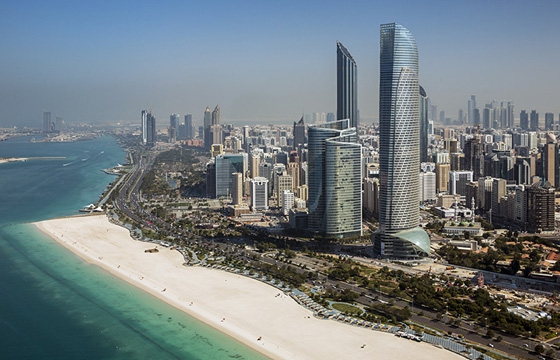Abu Dhabi has experienced significant change this year as the energy resource-rich emirate faces a second consecutive year of lower hydrocarbons income.
However, buoyed by ongoing diversification efforts, a recently released five-year plan for 2016-20 and large-scale restructuring of state-owned entities, Abu Dhabi has weathered economic headwinds and fared better than many of its peers.
While the government continues to rein in spending and tap foreign asset holdings to plug budget deficits in the short term, a sound fiscal position places Abu Dhabi on the path to accommodate a prolonged swing in the commodities cycle.
Peaks and troughs
In October the IMF predicted that GDP growth in Abu Dhabi would dip to 1.5% this year, down from 4.3% last year. While some indicators, such as consumer confidence and non-oil growth, demonstrated resilience at year-end, the emirate’s economy remains influenced by commodity prices and associated government spending.
Key sectors like real estate and hospitality saw moderate declines this year, with rental rates for prime units in Abu Dhabi down 5% year-on-year (y-o-y) in the third quarter of 2016, according to real estate consultancy firm JLL, citing job cuts in both public and private sectors. Average daily rates of hotels also dropped 10% y-o-y to $121 in the third quarter, with occupancy decreasing by 2.3% y-o-y to 70%.
Other sectors like financial services faced challenges as well, with banks experiencing liquidity pressure as deposits from government entities slowed.
Across the board, however, many positive announcements bucked regional trends, including a series of mega-mergers, a number of tenders awarded by Abu Dhabi General Services Company (Musanada) for infrastructure development projects, new supply deals in the emirate’s growing aerospace industry and the unveiling of bankruptcy legislation set to be operational early next year.
In July ratings agency Fitch maintained the emirate’s investment grade at “AA”, citing its ability to weather weak oil prices through robust foreign sovereign assets and low debt levels.
Restructuring efforts
2016 has also seen a series of high-profile consolidations, as companies moved to strengthen their balance sheets and achieve integration across business units.
The first major announcement was the merger between National Bank of Abu Dhabi and First Gulf Bank, which was approved by both boards in July and is expected to be finalized in the first quarter of 2017. The companies will join to become one of the largest bank by assets in the MENA region with Dh642bn ($174.8bn).
The deal could potentially trigger further consolidations in the UAE’s financial services sector, where approximately 50 lenders compete in a market of 9m people.
Meanwhile, two of the emirate’s largest sovereign investment funds – Mubadala Development Company, the Abu Dhabi-based investment and development company, and the International Petroleum Investment Company (IPIC) – announced plans to merge, creating a single entity with more than $135bn in assets and $42bn in debt, international media reported in June.
More recently, in October the Abu Dhabi National Oil Company (ADNOC) announced the consolidation of its offshore subsidiaries, the Abu Dhabi Marine Operating Company and the Zakum Development Company by the end of 2017, while three of ADNOC’s marine and shipping companies – the Petroleum Services Company, the Abu Dhabi National Tanker Company and the Abu Dhabi Petroleum Ports Operating Company – will combine operations, also by the end of next year, the company said.
The education sector has also seen restructuring, with authorities approving the unification of the Petroleum Institute, the Masdar Institute of Science and Technology and Khalifa University in October. The recent move is aimed at harnessing resources to develop a stronger, research-based institution.
Abu Dhabi at 50
This year marks the 50th year anniversary of the Abu Dhabi Executive Council – the executive branch of the local government responsible for setting and monitoring the implementation of general policy and the emirate’s development plans, as well as authorizing projects and decrees.
In 1966 the Council drew up the emirate’s first five-year Abu Dhabi Plan, emphasizing economic development and infrastructure, including education, health and transportation links.
These initial plans laid the groundwork for the emirate’s rapid expansion seen in ensuing decades, with GDP increasing from nearly Dh3.3bn ($898.5m) in 1970 to Dh960bn ($261bn) in 2014, and population rising from 66,700 in 1970 to 2.8m in mid-2015, according to figures from the Statistics Centre – Abu Dhabi.
The newest five-year instalment of the Abu Dhabi Plan – which supports the emirate’s long-term Economic Vision 2030 – was released in mid-2016 and focuses on five main areas: social development; economic development; infrastructure and environment; security, justice and safety; and government affairs. Within these sectors, the Abu Dhabi Executive Council has outlined 25 specific policy priorities, such as environmental sustainability and food security.
The newest plan includes social goals such as reducing unemployment by half – which stood at 3.7% last year, according to government figures – by focusing on creating jobs in Al Ain and ensuring all children are literate by 2020. Authorities also aim to expand the volume of foreign direct investment and increase tourism revenues under the plan.
The Abu Dhabi Plan provides an overarching policy direction for the emirate, with government entities aligning their objectives to those of the plan.
Oxford Business Group
15 December























































